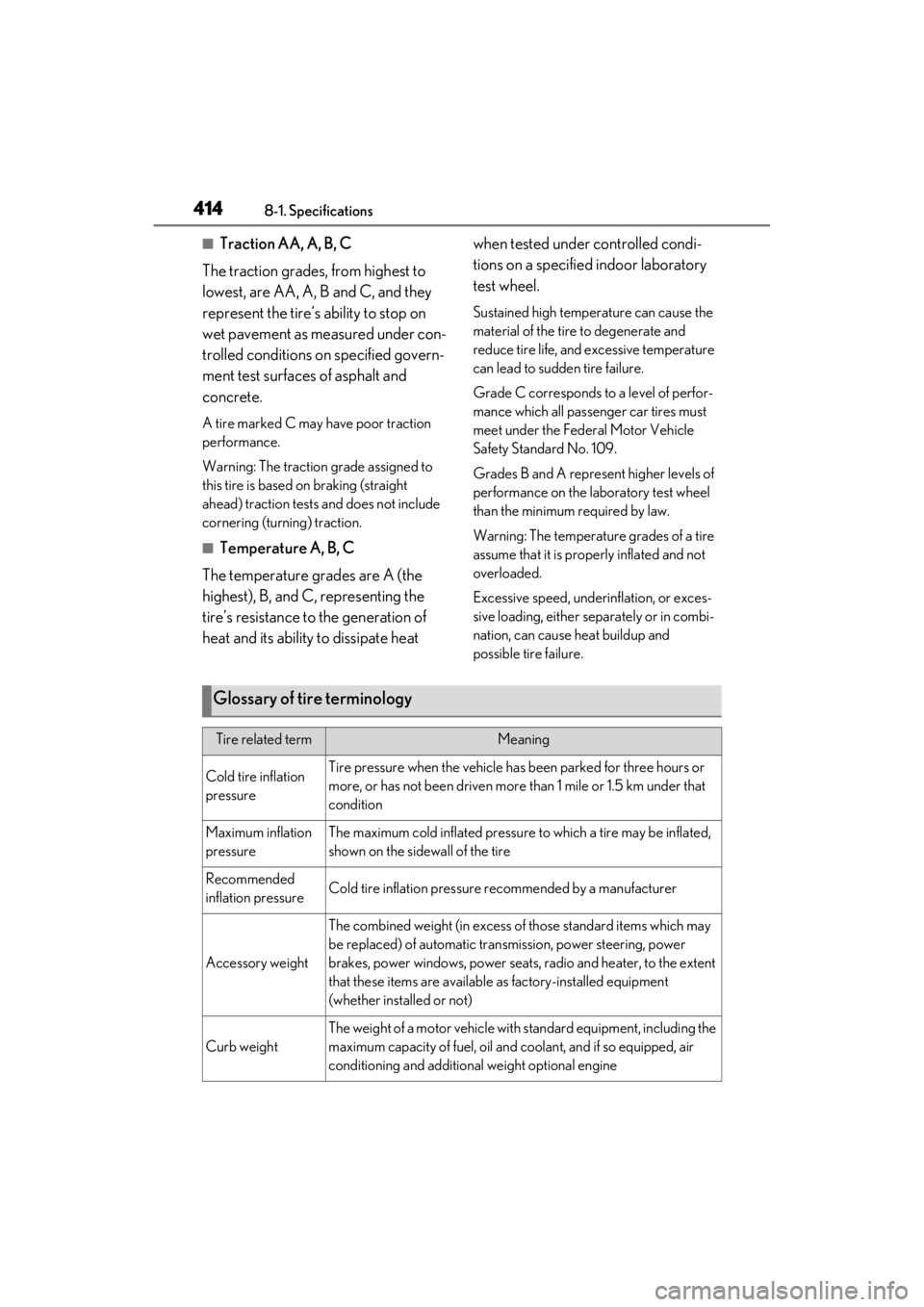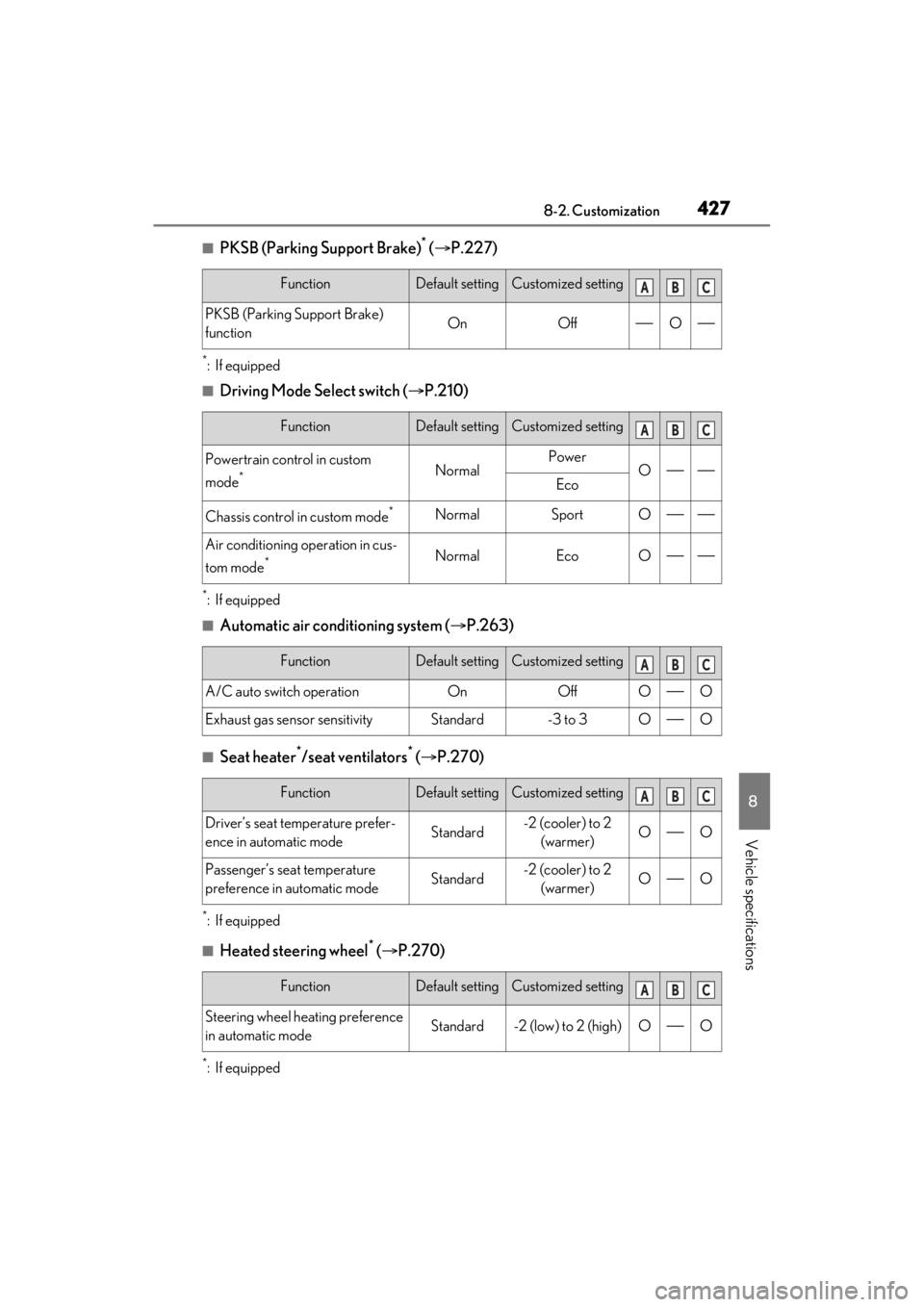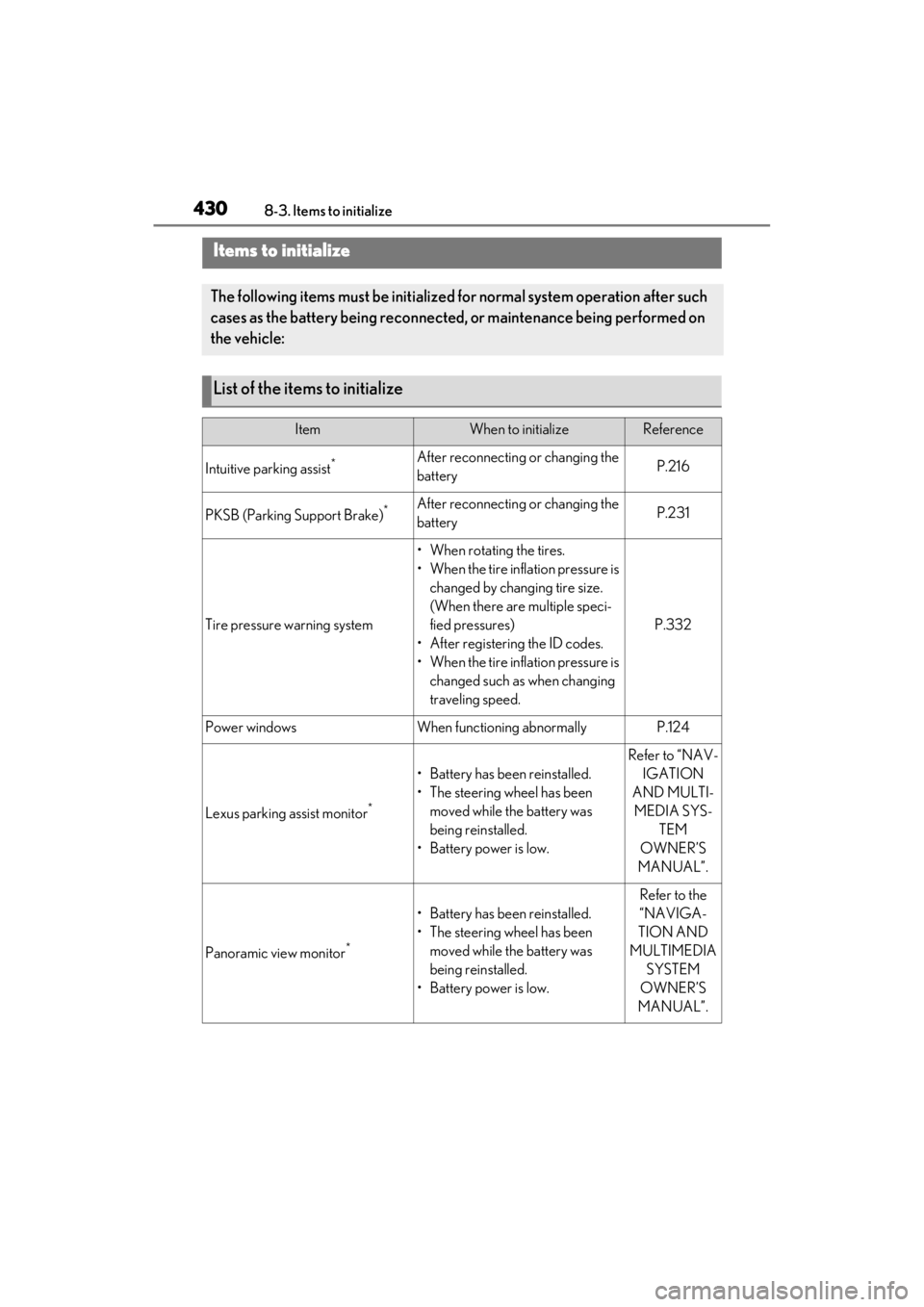2021 LEXUS ES350 brake
[x] Cancel search: brakePage 414 of 464

4148-1. Specifications
■Traction AA, A, B, C
The traction grades, from highest to
lowest, are AA, A, B and C, and they
represent the tire’s ability to stop on
wet pavement as measured under con-
trolled conditions on specified govern-
ment test surfaces of asphalt and
concrete.
A tire marked C may have poor traction
performance.
Warning: The traction grade assigned to
this tire is based on braking (straight
ahead) traction tests and does not include
cornering (turning) traction.
■Temperature A, B, C
The temperature grades are A (the
highest), B, and C, representing the
tire’s resistance to the generation of
heat and its ability to dissipate heat when tested under controlled condi-
tions on a specified indoor laboratory
test wheel.
Sustained high temperature can cause the
material of the tire to degenerate and
reduce tire life, and excessive temperature
can lead to sudd
en tire failure.
Grade C corresponds to a level of perfor-
mance which all passenger car tires must
meet under the Fede ral Motor Vehicle
Safety Standard No. 109.
Grades B and A represent higher levels of
performance on the laboratory test wheel
than the minimum required by law.
Warning: The temperature grades of a tire
assume that it is properly inflated and not
overloaded.
Excessive speed, unde rinflation, or exces-
sive loading, either separately or in combi-
nation, can cause heat buildup and
possible tire failure.
Glossary of tire terminology
Tire related termMeaning
Cold tire inflation
pressureTire pressure when the vehicle has been parked for three hours or
more, or has not been driven more than 1 mile or 1.5 km under that
condition
Maximum inflation
pressureThe maximum cold inflated pressure to which a tire may be inflated,
shown on the sidewall of the tire
Recommended
inflation pressureCold tire inflation pressure recommended by a manufacturer
Accessory weight
The combined weight (in excess of those standard items which may
be replaced) of automatic tran smission, power steering, power
brakes, power windows, power seats, radio and heater, to the extent
that these items are available as factory-installed equipment
(whether installed or not)
Curb weight
The weight of a motor vehicle with standard equipment, including the
maximum capacity of fuel, oil and coolant, and if so equipped, air
conditioning and additional weight optional engine
Page 415 of 464

4158-1. Specifications
8
Vehicle specifications
Maximum loaded
vehicle weight
The sum of:
(a) Curb weight
(b) Accessory weight
(c) Vehicle capacity weight
(d) Production options weight
Normal occupant
weight150 lb. (68 kg) times the number of occupants specified in the sec-
ond column of Table 1
* that follows
Occupant distribu-
tionDistribution of occupants in a vehicl e as specified in the third column
of Table 1
* below
Production options
weight
The combined weight of installed regular production options weigh-
ing over 5 lb. (2.3 kg) in excess of the standard items which they
replace, not previously considered in curb weight or accessory
weight, including heavy duty brakes , ride levelers, roof rack, heavy
duty battery, and special trim
RimA metal support for a tire or a tire and tube assembly upon which the
tire beads are seated
Rim diameter
(Wheel diameter)Nominal diameter of the bead seat
Rim size designationRim diameter and width
Rim type designa-
tionThe industry manufacturer’s designation for a rim by style or code
Rim widthNominal distance between rim flanges
Vehicle capacity
weight (Total load
capacity)The rated cargo and luggage load plus 150 lb. (68 kg) times the
vehicle’s designated seating capacity
Vehicle maximum
load on the tireThe load on an individual tire that is determined by distributing to
each axle its share of the maximum loaded vehicle weight, and divid-
ing by two
Vehicle normal load
on the tire
The load on an individual tire that is determined by distributing to
each axle its share of curb weight, accessory weight, and normal
occupant weight (dis tributed in accordance with Table 1
* below),
and dividing by two
Weather sideThe surface area of the rim not covered by the inflated tire
Tire related termMeaning
Page 419 of 464

4198-2. Customization
8
Vehicle specifications
8-2.Customization
■Changing by using the meter con-
trol switches
1 Press or to select .
2 Operate the meter control
switches to select the desired item
to be customized.
3 According to the display, select the
desired setting.
To go back to the previous screen or exit
the customize mode, press .
■Changing by using the Remote
Touch
1 Press the “MENU” button on the
Remote Touch.
2 Select “Setup” on the menu screen
and select “Vehicle”. 3
Select “Vehicle Cu stomization” or
“Drive Mode Customization”.
Various setting can be changed. Refer to
the list of settings th at can be changed for
details.
For details on the Remote Touch, refer
to the “NAVIGATION AND MULTI-
MEDIA SYSTEM OWNER’S MAN-
UAL”.
■When customizing using the Remote
Touch
Stop the vehicle in a safe place, apply the
parking brake, and shift the shift lever to P.
Also, to prevent battery discharge, leave
the engine running while customizing the
features.
Some function settings are changed simultaneously with other functions being cus-
tomized. Contact your Lexus dealer for further details.
Settings that can be changed using the Remote Touch
Settings that can be changed using the meter control switches
Customizable features
Your vehicle includes a variety of
electronic features that can be per-
sonalized to your preferences. The
settings of these features can be
changed by using the meter control
switches, the Remote Touch or at
your Lexus dealer.
Customizing vehicle features
WARNING
■During customization
As the engine needs to be running
during customization, ensure that the
vehicle is parked in a place with ade-
quate ventilation. In a closed area such as
a garage, exhaust gases including harm-
ful carbon monoxide (CO) may collect
and enter the vehicle. This may lead to
death or a serious health hazard.
NOTICE
■During customization
To prevent battery discharge, ensure
that the engine is running while custom-
izing features.
Customizable features
A
B
Page 427 of 464

4278-2. Customization
8
Vehicle specifications
■PKSB (Parking Support Brake)* ( P.227)
*:If equipped
■Driving Mode Select switch ( P.210)
*:If equipped
■Automatic air conditioning system ( P.263)
■Seat heater*/seat ventilators* ( P.270)
*:If equipped
■Heated steering wheel* ( P.270)
*:If equipped
FunctionDefault settingCustomized setting
PKSB (Parking Support Brake)
functionOnOffO
FunctionDefault settingCustomized setting
Powertrain control in custom
mode
*NormalPowerOEco
Chassis control in custom mode*NormalSportO
Air conditioning operation in cus-
tom mode
*NormalEcoO
FunctionDefault settingCustomized setting
A/C auto switch operationOnOffOO
Exhaust gas sensor sensitivityStandard-3 to 3OO
FunctionDefault settingCustomized setting
Driver’s seat temperature prefer-
ence in automatic modeStandard-2 (cooler) to 2
(warmer)OO
Passenger’s seat temperature
preference in automatic modeStandard-2 (cooler) to 2 (warmer)OO
FunctionDefault settingCustomized setting
Steering wheel heating preference
in automatic modeStandard-2 (low) to 2 (high)OO
ABC
ABC
ABC
ABC
ABC
Page 430 of 464

4308-3. Items to initialize
8-3.Items to initialize
Items to initialize
The following items must be initialized for normal system operation after such
cases as the battery being reconnected, or maintenance being performed on
the vehicle:
List of the items to initialize
ItemWhen to initializeReference
Intuitive parking assist*After reconnecting or changing the
batteryP.216
PKSB (Parking Support Brake)*After reconnecting or changing the
batteryP.231
Tire pressure warning system
• When rotating the tires.
• When the tire inflation pressure is changed by changing tire size.
(When there are multiple speci-
fied pressures)
• After registering the ID codes.
• When the tire inflation pressure is changed such as when changing
traveling speed.
P.332
Power windowsWhen functioning abnormallyP.124
Lexus parking assist monitor*
•Battery has be en reinstalled.
• The steering wheel has been moved while the battery was
being reinstalled.
• Battery power is low.
Refer to “NAV- IGATION
AND MULTI- MEDIA SYS- TEM
OWNER’S
MANUAL”.
Panoramic view monitor*
•Battery has be en reinstalled.
• The steering wheel has been moved while the battery was
being reinstalled.
• Battery power is low.
Refer to the
“NAVIGA-
TION AND
MULTIMEDIA SYSTEM
OWNER’S
MANUAL”.
Page 446 of 464

446What to do if... (Troubleshooting)
1-1.What to do if... (Troubleshooting)What to do if... (Troubleshooting)
If you lose your mechanical keys,
new genuine mechanical keys can
be made by your Lexus dealer.
( P.386)
If you lose your electronic keys, the
risk of vehicle theft increases signifi-
cantly. Contact your Lexus dealer
immediately. ( P.386)
Is the electronic key battery weak or
depleted? ( P.341)
Is the engine switch in IGNITION
ON mode?
When locking the doors, turn the engine
switch off. ( P.147)
Is the electronic key left inside the
vehicle?
When locking the doors, make sure that
you have the electronic key on your per-
son.
The function may not operate prop-
erly due to the condition of the radio
wave. ( P.108)
Is the child-protector lock set?
The rear door cannot be opened
from inside the vehicle when the
lock is set.
Open the rear door from outside
and then unlock the child-protector
lock. ( P.98)
The function to prevent the elec-
tronic key from being left inside the
trunk will operate and you can open
the trunk as usual. Take the key out
from the trunk. ( P.103)
Did you press the engine switch
while firmly depressing the brake
pedal? ( P.144)
Is the shift lever in P? ( P.149)
Is the electronic key anywhere
detectable inside the vehicle?
( P.106)
Is the steering wheel unlocked?
( P.145)
Is the electronic key battery weak or
depleted?
If you have a problem, check the
following before contacting your
Lexus dealer.
The doors cannot be locked,
unlocked, opened or closed
You lose your keys
The doors cannot be locked or
unlocked
The rear door cannot be opened
The trunk lid is closed with the
electronic key left inside
If you think something is wrong
The engine does not start
Page 447 of 464

447What to do if... (Troubleshooting)
In this case, the engine can be started in a
temporary way. ( P.388)
Is the battery discharged?
( P.389)
Is the engine switch in IGNITION
ON mode?
If you cannot release the shift lever
by depressing the brake pedal with
the engine switch in IGNITION ON
mode ( P.150)
It is locked automatically to prevent
theft of the vehicle. ( P.145)
Is the window lock switch pressed?
The power window at the except for the
one at the driver’s seat cannot be operated
if the window lock switch is pressed.
( P.125)
The auto power off function will be
operated if the vehicle is left in
ACCESSORY or IGNITION ON
mode (the engine is not running) for
a period of time. ( P.147)
The seat belt reminder light is flash-
ing
Are the driver and the passengers wearing
the seat belts? ( P.364)
The parking brake indicator is on
Is the parking brake released? ( P.154)
Depending on the situation, other
types of warning buzzer may also
sound. ( P.361, 371)
Did anyone inside the vehicle open
a door during setting the alarm?
The sensor detects it and the alarm sounds.
( P.63)
To stop the alarm, turn the engine
switch to IGNITION ON mode, or
start the engine.
Is the message displayed on the
multi-information display?
Check the message on the multi-informa-
tion display. ( P.371)
When a warning light turns on or a
warning message is displayed, refer
to P.361, 371.
The shift lever cannot be shifted
from P even if you depress the
brake pedal
The steering wheel cannot be
turned after the engine is
stopped
The windows do not open or
close by operating the power
window switches
The engine switch is turned off
automatically
A warning buzzer sounds during
driving
An alarm is activated and the
horn sounds
A warning buzzer sounds when
leaving the vehicle
A warning light turns on or a
warning message is displayed
Page 449 of 464

449Alphabetical index
Alphabetical index
A
A/C ................................................................... 263Air conditioning filter ............................... 339
Automatic air conditioning system ... 263
ABS (Anti-lock Brake System).............. 246 Function .......................................................... 246
Warning light ............................................... 363
ACA (Active Cornering Assist) ........... 246
Active Cornering Assist (ACA) ........... 246
Adaptive Front-lighting System (AFS) 160
Adaptive Variable Suspension System247
AFS (Adaptive Front-lighting System) 160
Airbags ............................................................... 28 Airbag operating conditions................... 30
Airbag precautions for your child ........ 33
Correct driving posture .............................23
Curtain shield airbag operating condi- tions .................................................................... 31
Curtain shield airbag precautions ....... 33
Front passenger occupant classification system ..............................................................37
General airbag precautions ................... 33
Locations of airbags.................................... 28
Modification and disposal of airbags . 35
Side airbag operating conditions ........... 31
Side airbag precautions ............................ 33
Side and curtain shield airbags operating conditions........................................................ 31
Side and curtain shield airbags precau- tions .................................................................. 33
SRS airbags ..................................................... 28
SRS warning light ...................................... 362
Air conditioning filter ................................. 339
Air conditioning system ............................ 263 Air conditioning filter ............................... 339
Automatic air conditioning system ... 263
Alarm ................................................................... 63 Alarm .................................................................. 63
Warning buzzer ...........................................361
Anchor brackets ..................................... 44, 53
Antennas (smart access system with push- button start) ................................................. 106
Anti-lock Brake System (ABS).............. 246 Function .......................................................... 246
Warning light ...............................................363
Approach warning........................................201
Armrest............................................................ 290
Assist grips ..................................................... 290
Audio system-linked display ...................... 82
Automatic headlight leveling system ....159
Automatic High Beam ................................. 161
Automatic light control system............... 158
Automatic transmission ..............................149 Paddle shift switches .........................151, 152
S mode ............................................................. 152
Auxiliary box.................................................. 279
Average fuel economy..................................79
Average vehicle speed .................................79
B
Back-up lights Replacing light bulbs ................................346
Battery Checking ....................................................... 323
If the battery is discharged ................... 389
Preparing and checking before winter........................................................................... 251
Warning light ...............................................362
Blind Spot Monitor (BSM)....................... 205
Boost gauge........................................................81
Brake Brake hold ...................................................... 156
Fluid.................................................................. 404
Parking brake ............................................... 154
Warning light ................................................ 361
Brake assist .................................................... 246
Break-in tips.....................................................135
Brightness control Instrument panel light control......... 72, 76
BSM (Blind Spot Monitor)....................... 205